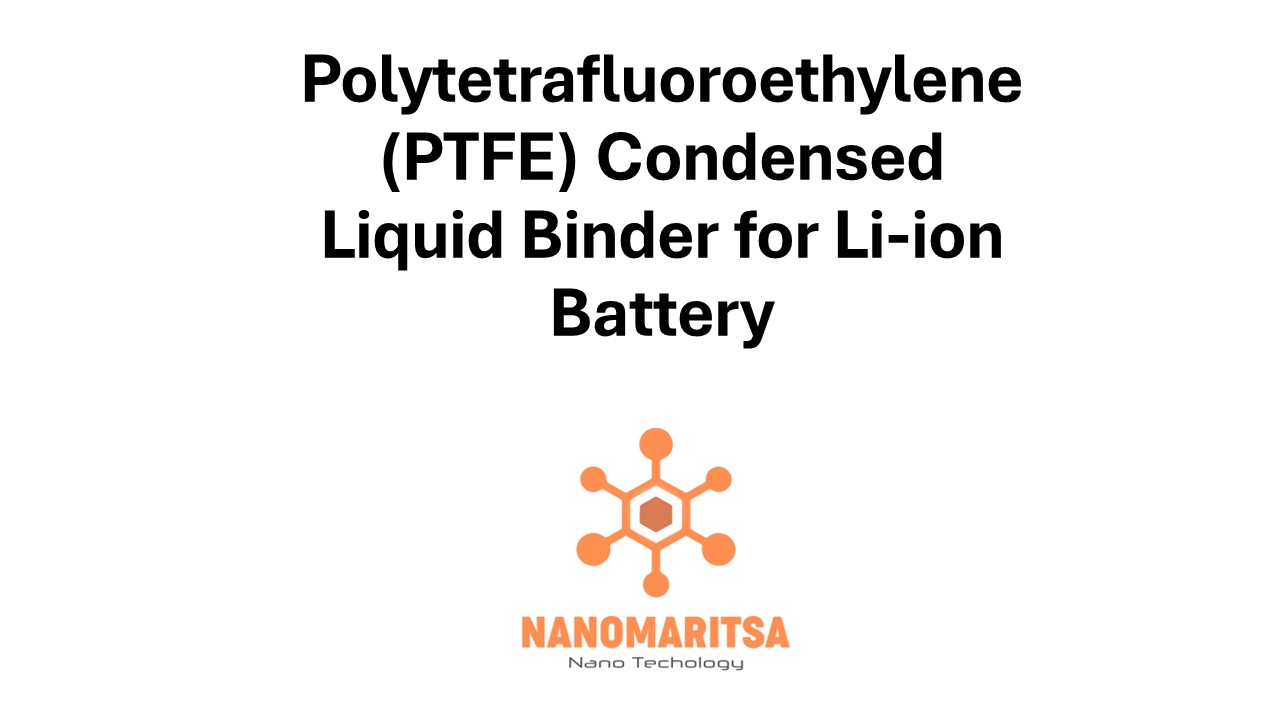Polytetrafluoroethylene (PTFE) Condensed Liquid Binder for Li-ion Batteries is a high-performance binder material specifically designed to enhance the mechanical stability and electrochemical performance of lithium-ion battery electrodes. PTFE is known for its excellent chemical stability, thermal resistance, and adhesive properties, making it a reliable choice for electrode manufacturing in applications such as electric vehicles (EVs), energy storage systems (ESS), and portable electronics.
1. Key Properties
High Chemical Stability PTFE is highly resistant to chemical degradation, ensuring durability and longevity in harsh electrochemical environments.
Excellent Adhesion PTFE binder provides strong binding between active materials and current collectors, maintaining electrode integrity during charge and discharge cycles.
Thermal Stability With high thermal resistance, PTFE can withstand elevated temperatures during battery operation, contributing to the safety and reliability of the battery.
Low Reactivity PTFE is inert to most chemicals and solvents, ensuring that it does not interfere with the electrochemical performance of the battery.
Flexible Film Formation PTFE’s ability to form flexible, durable films ensures mechanical stability and prevents cracking or delamination of the electrodes.
Enhanced Mechanical Strength The binder improves the mechanical properties of the electrode, helping to sustain structural integrity under repeated cycling.
2. Applications
Lithium-Ion Batteries PTFE condensed liquid binder is primarily used in the production of lithium-ion batteries, ensuring strong adhesion and mechanical stability for both anodes and cathodes.
Electric Vehicles (EVs) PTFE binder contributes to the high performance and reliability of lithium-ion batteries in EVs, where durability and safety are essential.
Energy Storage Systems (ESS) Used in large-scale energy storage solutions, PTFE binder enhances the longevity and performance of batteries in grid stabilization and renewable energy applications.
Portable Electronics PTFE binder is employed in batteries for smartphones, laptops, tablets, and other consumer electronics, providing high energy density and long cycle life.
Medical Devices Utilized in batteries for portable medical devices, PTFE ensures stable and reliable performance over extended use.
High-Performance Applications PTFE binder is particularly suited for high-power and high-temperature applications, where its stability and durability are critical.
3. Advantages
Superior Stability PTFE binder offers excellent thermal and chemical stability, ensuring reliable performance in demanding battery applications.
Improved Cycle Life By maintaining electrode integrity and preventing material degradation, PTFE binder extends the cycle life of lithium-ion batteries.
Enhanced Safety The high thermal resistance of PTFE contributes to improved safety in lithium-ion batteries, especially in high-temperature and high-power applications.
Efficient Processing PTFE condensed liquid binder is easy to process and integrate into electrode manufacturing, providing consistent performance across various battery designs.
Wide Compatibility PTFE binder is compatible with a range of active materials, including lithium cobalt oxide (LiCoO₂), lithium iron phosphate (LiFePO₄), and lithium nickel manganese cobalt oxide (NMC).
Low Maintenance The binder’s chemical inertness and stability reduce the need for frequent maintenance or replacement, contributing to the overall cost-effectiveness of the battery.
4. Recent Trends and Research
Binder Optimization for High-Capacity Materials As the demand for higher-capacity battery materials like silicon-based anodes increases, PTFE binders are being optimized to address challenges such as volume expansion and cycling degradation.
Enhanced Electrode Design Researchers are exploring the role of PTFE binders in improving the structural and electrochemical properties of electrodes, particularly for next-generation battery chemistries.
Solid-State Batteries PTFE is being investigated for its potential use in solid-state batteries, where its chemical stability and flexibility can contribute to improved performance and safety.
Binder Additives and Modifications Research into blending PTFE with other materials, such as conductive polymers, aims to further enhance conductivity and electrode performance.
Sustainability Efforts to make binder materials more sustainable are focusing on reducing production costs, improving recyclability, and developing eco-friendly manufacturing processes.
5. Future Prospects
Electric Vehicle Market Expansion As EV adoption grows, PTFE binder will remain essential in ensuring the performance and safety of high-capacity batteries used in EVs.
Advanced Energy Storage Solutions PTFE binder’s role in improving electrode stability will be pivotal in next-generation energy storage systems, supporting renewable energy integration and grid stability.
Solid-State Battery Development PTFE binders are expected to play a role in the development of solid-state batteries, which promise improved safety, energy density, and longevity.
Portable and Wearable Electronics As demand for lightweight, long-lasting batteries in portable and wearable devices grows, PTFE binders will contribute to the durability and performance of these batteries.
Next-Generation Battery Chemistries PTFE will remain a key material in supporting advanced chemistries like silicon-anode and lithium-sulfur batteries, addressing challenges related to cycling stability and material expansion.
With its chemical stability, thermal resistance, and exceptional adhesive properties, Polytetrafluoroethylene (PTFE) Condensed Liquid Binder for Li-ion Batteries is a critical component for the production of reliable and high-performance lithium-ion batteries. Its versatility and performance ensure its continued importance in energy storage technologies for EVs, ESS, portable electronics, and emerging battery innovations.






